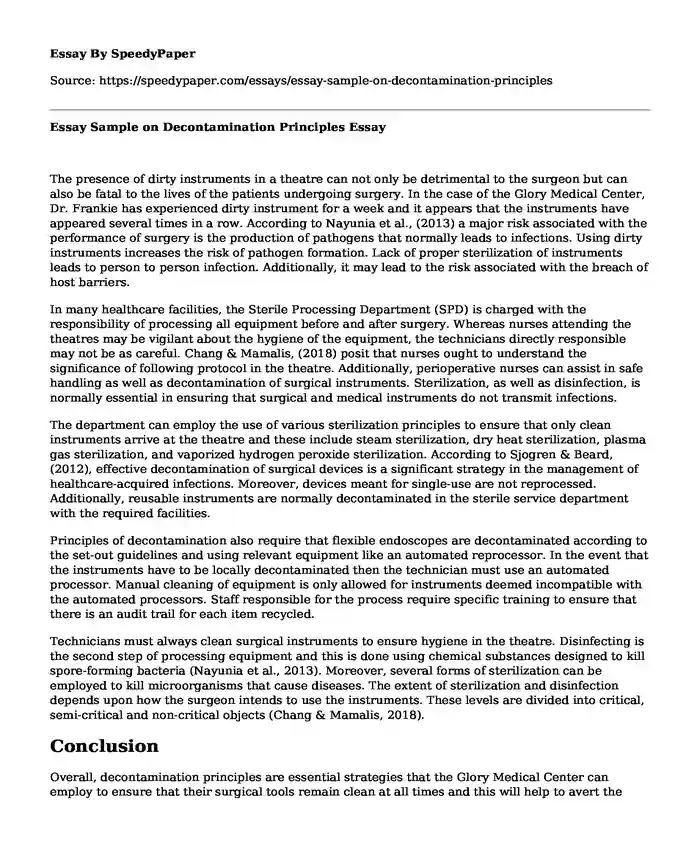
| Type of paper: | Essay |
| Categories: | Surgery Healthcare Risk management |
| Pages: | 3 |
| Wordcount: | 597 words |
The presence of dirty instruments in a theatre can not only be detrimental to the surgeon but can also be fatal to the lives of the patients undergoing surgery. In the case of the Glory Medical Center, Dr. Frankie has experienced dirty instrument for a week and it appears that the instruments have appeared several times in a row. According to Nayunia et al., (2013) a major risk associated with the performance of surgery is the production of pathogens that normally leads to infections. Using dirty instruments increases the risk of pathogen formation. Lack of proper sterilization of instruments leads to person to person infection. Additionally, it may lead to the risk associated with the breach of host barriers.
In many healthcare facilities, the Sterile Processing Department (SPD) is charged with the responsibility of processing all equipment before and after surgery. Whereas nurses attending the theatres may be vigilant about the hygiene of the equipment, the technicians directly responsible may not be as careful. Chang & Mamalis, (2018) posit that nurses ought to understand the significance of following protocol in the theatre. Additionally, perioperative nurses can assist in safe handling as well as decontamination of surgical instruments. Sterilization, as well as disinfection, is normally essential in ensuring that surgical and medical instruments do not transmit infections.
The department can employ the use of various sterilization principles to ensure that only clean instruments arrive at the theatre and these include steam sterilization, dry heat sterilization, plasma gas sterilization, and vaporized hydrogen peroxide sterilization. According to Sjogren & Beard, (2012), effective decontamination of surgical devices is a significant strategy in the management of healthcare-acquired infections. Moreover, devices meant for single-use are not reprocessed. Additionally, reusable instruments are normally decontaminated in the sterile service department with the required facilities.
Principles of decontamination also require that flexible endoscopes are decontaminated according to the set-out guidelines and using relevant equipment like an automated reprocessor. In the event that the instruments have to be locally decontaminated then the technician must use an automated processor. Manual cleaning of equipment is only allowed for instruments deemed incompatible with the automated processors. Staff responsible for the process require specific training to ensure that there is an audit trail for each item recycled.
Technicians must always clean surgical instruments to ensure hygiene in the theatre. Disinfecting is the second step of processing equipment and this is done using chemical substances designed to kill spore-forming bacteria (Nayunia et al., 2013). Moreover, several forms of sterilization can be employed to kill microorganisms that cause diseases. The extent of sterilization and disinfection depends upon how the surgeon intends to use the instruments. These levels are divided into critical, semi-critical and non-critical objects (Chang & Mamalis, 2018).
Conclusion
Overall, decontamination principles are essential strategies that the Glory Medical Center can employ to ensure that their surgical tools remain clean at all times and this will help to avert the formation of pathogens which cause bacterial infections. Selection of a sterilization or disinfection process must be done by consideration of the merits as well as the demerits of the procedures. Besides sterilization, basic hand hygiene is also essential to ensure total hygiene within the hospital environment.
References
Chang, D., & Mamalis, N. (2018). Guidelines for the cleaning and sterilization of intraocular surgical instruments. Journal of Cataract and Refractive Surgery, 44(6), 765-773. doi: 10.1016/j.jcrs.2018.05.001
Nayunia, K., Cloutman-Green, E., Hollisb, M., Hartley, J., Martinc, S., & Perretta, D. (2013). Critical evaluation of ninhydrin for monitoring surgical instrument decontamination. Journal of Hospital Infection, 84(2), 97-102. doi: 10.1016/j.jhin.2012.11.029
Sjogren, G., & Beard, R. (2012). Principles of Decontamination. Imaging and Technology in Urology, 1(1), 257-260. Doi. 10.1177/0748233712448112.
Cite this page
Essay Sample on Decontamination Principles. (2023, Jan 28). Retrieved from https://speedypaper.net/essays/essay-sample-on-decontamination-principles
Request Removal
If you are the original author of this essay and no longer wish to have it published on the SpeedyPaper website, please click below to request its removal:
- Homeless in California, Essay Sample with Annotated Bibliography
- Free Essay Example about Negative Effects of Parental Detachment on the Children
- Essay Sample on Zika Virus Infection
- Paper Example on Financial Managers and Their Role in Achieving Financial Prosperity
- Essay Sample on Characteristics of a Professional or Competent Health Worker
- Free Paper Sample on Appreciation for Teachers and Need for Fairness in Education
- Background of ADA (1990) and Legal Implications - Essay Sample
Popular categories




